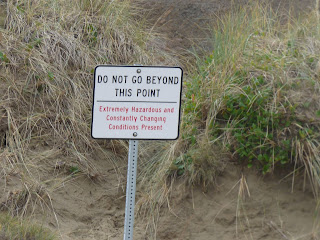The area was virtually deserted when we arrived. Quite a contrast to summer time. One car with people and a dog arrived before Johnny walked back. I went over the dune to look for Black Oystercatchers so did not even see that car. But there were lots of human and dog footprints and lots of car tracks.
 |
| Looking north from McPhillips Park |
 |
| Looking south from McPhillips Park (notice car tracks) |
 |
| lots of kelp on the beach |
 |
| first time I've seen these signs |
 |
| a fairly new eroded area and landslide |
 |
| a refrigerator casing |
 |
| the green stuff is a natural seaweed but so tangled together that it has all sorts of plastic debris trapped inside |
 |
| One of two dead birds we saw. This one is a white-winged Scoter. The other was a Western Grebe |
 |
| This is a dead and partly eaten marine mammal of some sort... seal or sea lion |
 |
| The dune keeps moving, making signage difficult. |
 |
| I had not noticed this cavity at the north end of the dune before |
 |
| It is an eroded hole at the edge of the dune. Will be interesting to see what it looks like next time. |
 |
| The sea stack is becoming more and more eroded by waves |
 |
| looking southwest to the end of mile 262 |
 |
| The cliff is becoming steeper and steeper |
 |
| This sign is at the base of the cliff pictured above |
 |
| You can tell by the tracks leading past the sign that it is being ignored |
 |
| Here is the sign and cliff from another angle |
 |
| Looking north toward Cape Lookout from the dune |
No comments:
Post a Comment